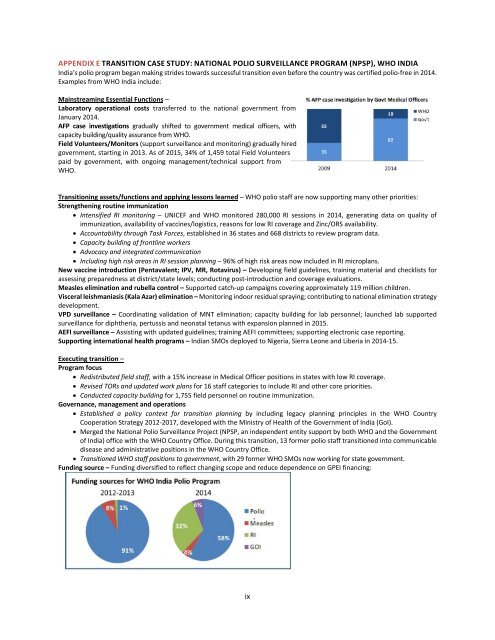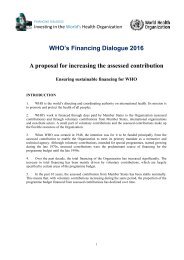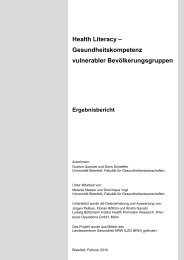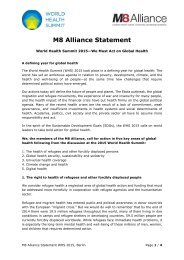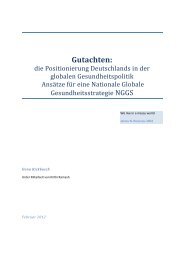POLIO PLANNING
TransitionGuidelinesForPolioLegacy
TransitionGuidelinesForPolioLegacy
Create successful ePaper yourself
Turn your PDF publications into a flip-book with our unique Google optimized e-Paper software.
APPENDIX E TRANSITION CASE STUDY: NATIONAL <strong>POLIO</strong> SURVEILLANCE PROGRAM (NPSP), WHO INDIA<br />
India’s polio program began making strides towards successful transition even before the country was certified polio-free in 2014.<br />
Examples from WHO India include:<br />
Mainstreaming Essential Functions –<br />
Laboratory operational costs transferred to the national government from<br />
January 2014.<br />
AFP case investigations gradually shifted to government medical officers, with<br />
capacity building/quality assurance from WHO.<br />
Field Volunteers/Monitors (support surveillance and monitoring) gradually hired<br />
government, starting in 2013. As of 2015, 34% of 1,459 total Field Volunteers<br />
paid by government, with ongoing management/technical support from<br />
WHO.<br />
Transitioning assets/functions and applying lessons learned – WHO polio staff are now supporting many other priorities:<br />
Strengthening routine immunization<br />
• Intensified RI monitoring – UNICEF and WHO monitored 280,000 RI sessions in 2014, generating data on quality of<br />
immunization, availability of vaccines/logistics, reasons for low RI coverage and Zinc/ORS availability.<br />
• Accountability through Task Forces, established in 36 states and 668 districts to review program data.<br />
• Capacity building of frontline workers<br />
• Advocacy and integrated communication<br />
• Including high risk areas in RI session planning – 96% of high risk areas now included in RI microplans.<br />
New vaccine introduction (Pentavalent; IPV, MR, Rotavirus) – Developing field guidelines, training material and checklists for<br />
assessing preparedness at district/state levels; conducting post-introduction and coverage evaluations.<br />
Measles elimination and rubella control – Supported catch-up campaigns covering approximately 119 million children.<br />
Visceral leishmaniasis (Kala Azar) elimination – Monitoring indoor residual spraying; contributing to national elimination strategy<br />
development.<br />
VPD surveillance – Coordinating validation of MNT elimination; capacity building for lab personnel; launched lab supported<br />
surveillance for diphtheria, pertussis and neonatal tetanus with expansion planned in 2015.<br />
AEFI surveillance – Assisting with updated guidelines; training AEFI committees; supporting electronic case reporting.<br />
Supporting international health programs – Indian SMOs deployed to Nigeria, Sierra Leone and Liberia in 2014-15.<br />
Executing transition –<br />
Program focus<br />
• Redistributed field staff, with a 15% increase in Medical Officer positions in states with low RI coverage.<br />
• Revised TORs and updated work plans for 16 staff categories to include RI and other core priorities.<br />
• Conducted capacity building for 1,755 field personnel on routine immunization.<br />
Governance, management and operations<br />
• Established a policy context for transition planning by including legacy planning principles in the WHO Country<br />
Cooperation Strategy 2012-2017, developed with the Ministry of Health of the Government of India (GoI).<br />
• Merged the National Polio Surveillance Project (NPSP, an independent entity support by both WHO and the Government<br />
of India) office with the WHO Country Office. During this transition, 13 former polio staff transitioned into communicable<br />
disease and administrative positions in the WHO Country Office.<br />
• Transitioned WHO staff positions to government, with 29 former WHO SMOs now working for state government.<br />
Funding source – Funding diversified to reflect changing scope and reduce dependence on GPEI financing:<br />
ix


